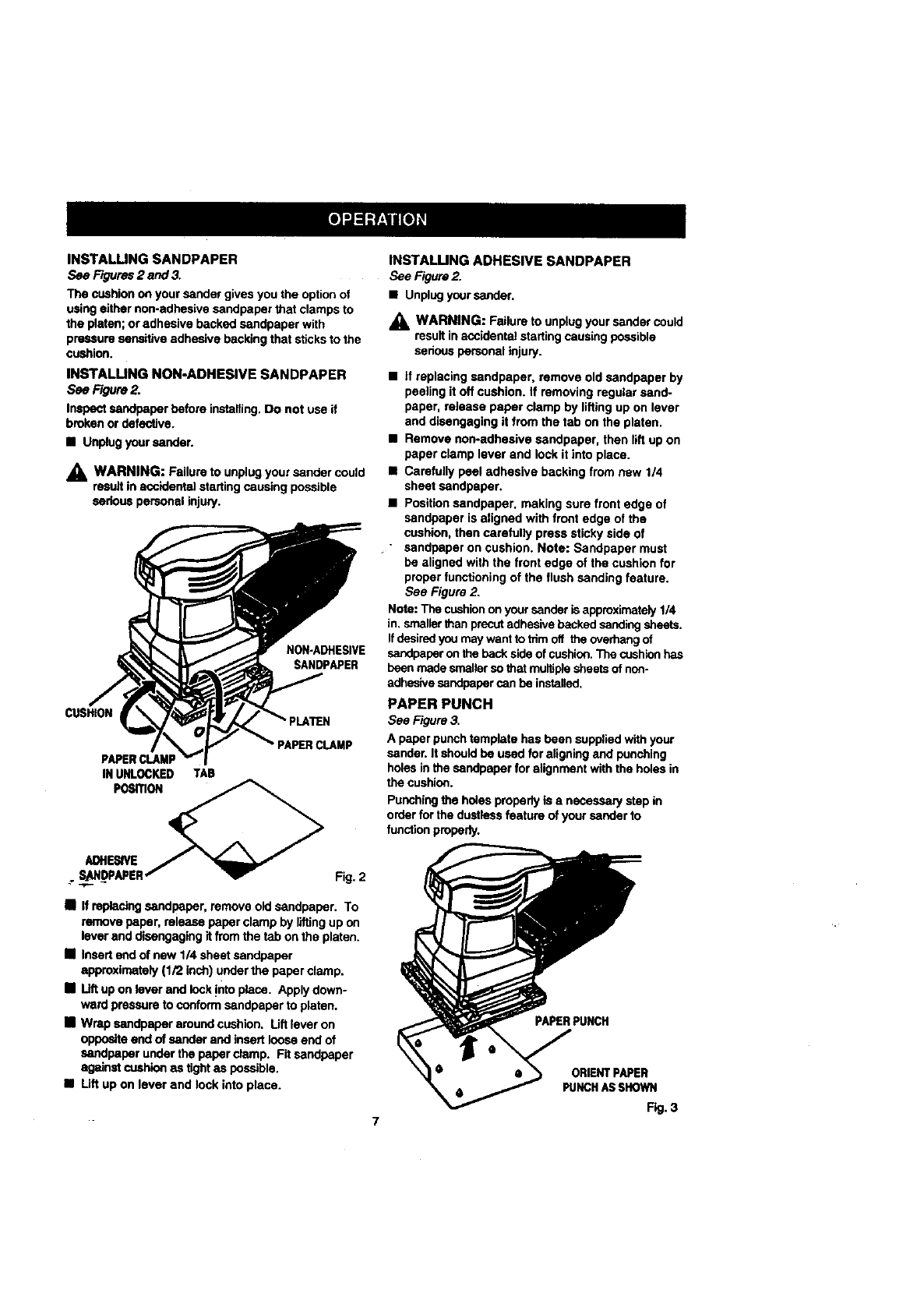
INSTALUNG SANDPAPER
See F_Jres E end 3,
The cushion on your sander gives you the option of
using either non-adhesive sandpaper that clamps to
the platen; Oradhesive backed sandpaper with
pressure sensitive adhesive backing that sticks to the
cushion,
INSTALUNG NON-ADHESIVE SANDPAPER
See Figure2.
Inspectsandpaperbeforeinstalling.Do not useif
brokenor defective.
• Unplug yoursender.
WARNING: Failure to unplug your sander could
resuR in accidental starting causing possible
serious personal injury.
NON-ADHESIVE
SANDPAPER
CUSHION
PAPERCLAMP
PAPERCLAMP
IN UNLOCKED TAB
POSITION _
.. SL.AN_DPAPER"" _ Fig. 2
• If replacing sandpaper, remove old sandpaper. To
remove paper, release paper clamp by liftingup on
lever and disengaging it from the tab on the platen.
• Insert end of new 114sheet sandpaper
approximately (1/2 inch) under the paper clamp.
• Lift up on lever and lock !nto place. Apply down-
ward pressure to conform sandpaper to platen.
• Wrap sandpaper around cushion, Uft lever on
opposite and of sander and insert loose end of
sandpaper under the paper clamp. Fit sandpaper
against cushion as tight as possible,
• Lift up on lever and lock into place.
7
INSTALUNG ADHESIVE SANDPAPER
See Figure 2.
• Unplug your sender.
_, WARNING: Failure to unplug your sender could
result in accidental starting causing possible
serious personal injury.
• if replacing sandpaper, remove old sandpaper by
peeling it off cushion. If removing regular send-
paper, release paper clamp by lifting up on lever
and disengaging it from the tab on the platen.
• Remove non-adhesive sandpaper, then lift up on
paper clamp lever and lock it into place.
• Carefully peel adhesive backing from new 1/4
sheet sandpaper.
• Position sandpaper, making sure front edge of
sandpaper is aligned with front edge of the
cushion, then carefully press sticky side of
" sandpaper on cushion. Note: Sandpaper must
be aligned with the front edge of the cushion for
proper functioning of the flush sanding feature.
See Figure 2.
Note: The cushionon your sander isapproximately 1/4
in, smaller than precut adhesive backed sanding sheets.
Ifdesired you may want to trim off the overhang of
sandpaper on the back side of cushion. The cushionhas
been made smaller so that multiple sheets of non.
adhesive sandpeper san he installed,
PAPER PUNCH
See Figure 3.
A paper punch template has been supplied with your
sander. It should be used for aligning and punching
holes in the sandpaper for alignment with the hales in
the cushion.
Punching the holes properly is a necessary step in
order for the dustless feature of your sender to
functionproperly.
PAPERPUNCH
ORIENTPAPER
PUNCHASSHOWN
Fig.3
















